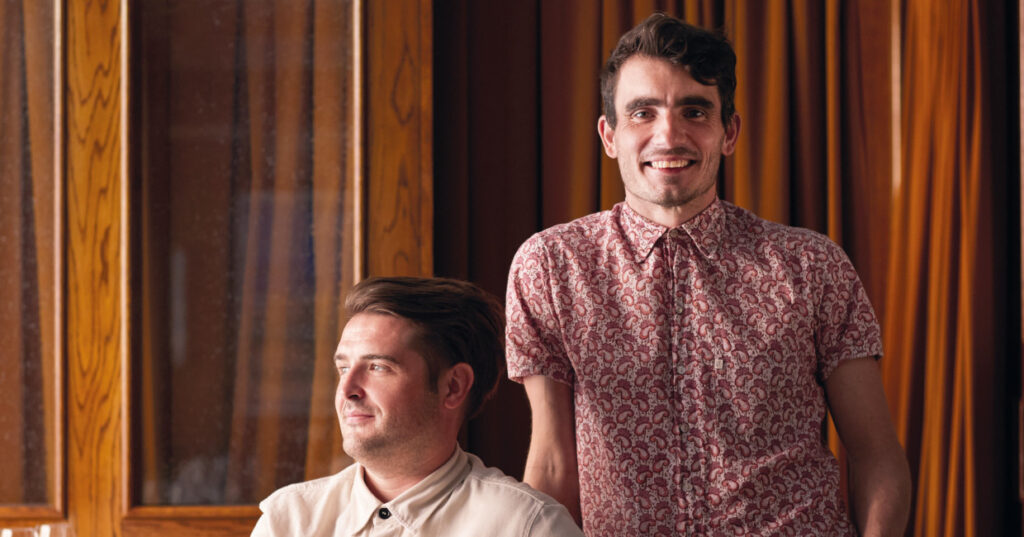The personal approach is key for the long-time friends and co-founders of Fettle Design Studio. With Tom based in LA and Andy in London, Vicky Doe was keen to find out how the studio maintains close relationships and creates designs fitting for spaces across the world.
Having both studied Interior Architecture at University, Andy and Tom met when working at United Designers, and struck up a close working relationship. A few years later, they both found themselves working at MBDS (Martin Brudnizki Design Studio) under Martin Brudnizki, and Tom relocated to the studio’s New York office. The hands-on experience they were given during their time at the studio allowed them to see projects through fully and experience the whole process. This became the starting point for where they are today.
Eight years into their working relationship, after spending much of their social time together too, they identified that they had similar aspirations for their working career and they decided to take the leap in 2015 and Fettle Design Studio was born.
Meeting at the beginning of Tom’s day and the end of Andy’s, we discussed their initial vision for Fettle’s ethos. Tom explained: “We knew we wanted to retain a personal perspective and to ensure that we maintained involvement with all the projects we take on.” They have always been clear that they wanted to retain creativity and involvement in every project on their books, and this is something they have successfully maintained.
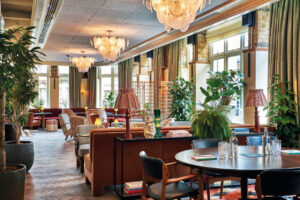
And did they always know that hospitality was the design arena for them? They were both very clear on this, absolutely sure that hospitality design was what excited them most. Andy explained: “It’s a unique place in the market and we are given the budgets to be able to create amazing experiences for people and that allows you to be creative in response to the brief. Within the hospitality field, you can be much more adventurous with the choices you make because people are only experiencing the design for short periods of time.
Trans-Atlantic designing
So, with studios on either side of the Atlantic, I was keen to find out how communication works – does each site function independently or is there collaboration? Andy explained: “When we first set up, there was much more cross pollination. That happens less now, but there is still collaborative work as there are some clients who work in the US and the UK. The client relationship and management, however, falls between Tom and I.”
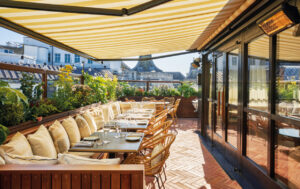
The benefit of having two studios working on a range of projects allows for a great deal of sharing of ideas and inspiration. Andy continued: “One of the major benefits we find is that ideas from the UK work really well in the US, and vice versa, and you see trends that transition through. We facilitate meetings between both teams to allow the teams to share different nuances and add to each overall project.”
I wanted to explore some of the projects that they have led on, and specifically those which they are particularly proud of. Maslow’s 1 Warwick in Soho was one that clearly stood out. A members’ house set in a Neo-Baroque mansion, the theme of the project is based on ‘Maslow’s theory of human motivation and happiness’. Fettle landed the contract at the start of the pandemic and it was a significant project for the team.
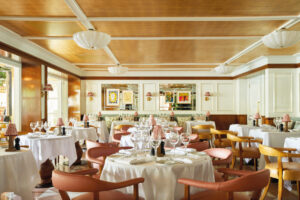
In a similar vein, Fettle completed on The Georgian Hotel in Santa Monica last year which had been a three-to-four-year project for the team. Tom explained: “It was a real build up to get to the end of both of those projects. The changes implemented by the pandemic created a challenge and the process we went through really summarises what the studio is about.
“When we were working on those projects, particularly during the pandemic, when everyone was struggling with financing, there were moments where it looked like both the projects were going to stop after a couple of years. Getting to that completion moment was a really significant achievement.”
He continued: “It’s probably one of the big reasons that we do love hospitality work – you get that sense of celebration at the end of a project where you get to share it with your friends and family and everyone can see what you’ve been working on for years.”
Challenges and obstacles
When I asked the question about challenges and obstacles they’ve had to overcome, both Andy and Tom laughed – “Has there been a single project we’ve done that’s been plain sailing? Probably not!” Andy mused.
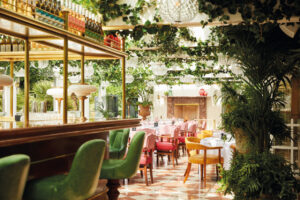
Tom explained that the greatest challenge they often face is the historic buildings they are working within and the regulations they have to abide by. “We have a track record of working with this kind of building so people approach us for that. These buildings are amazing as they give you this incredible narrative for the project. But at the same time, we have to find the balance between paying homage to the history of the building whilst also trying to create something new that’s going to work within the modern F&B landscape.”
Andy agreed, he added: “The two projects that have caused the biggest challenges would be 1 Warwick and The Georgian, for different reasons. We had a lot to contend with, but as Tom said, that’s where you get more gratification.”
Yet, Andy went on to explain that sometimes the smaller projects can create their own complications. He shared stories about the design and creation of Cicchetti in Knightsbridge, part of the San Carlo group of restaurants: “It was an incredibly tight site and in many ways it would have been easier for the client team and for us if it was bigger. But in smaller projects, the detail is likely to be higher than in others we’ve worked on – we really went to town on that project and the details were so key and so important to get right.”
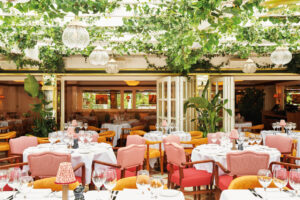
We talked about the challenge of ‘uniqueness’; Andy explained that whilst the firm often utilise the same custom furniture and lighting manufacturers, they work hard to create bespoke pieces for the client and the specific site. He said: “Even with San Carlo, where we are working with them across multiple sites, the furniture is bespoke for each individual one. It might be that the prototype is the same, but the fabric or size may change.”
Finding the narrative
So when Tom, Andy and the team sit down to begin a new project, what is their starting point? What influences them and their decision making?
Tom explained: “Within some of the more historic buildings, there’s a lot of research that goes into the building and the area and then elements of the client’s brand or brand history, or what it is they’re trying to achieve. It could be that there is one novel thing that stands out and we always build a very detailed narrative as our first step and then start to transition that into more visible touches.”
Andy agreed: “One of the things we crossover on both our studios is in the early stages – we review together what we are doing in terms of the narrative and the initial space plans. We do the two together before touching base with the client and from there, the inspiration images are sourced and developed. For F&B projects, the space planning needs to be on point from the start of the project – once you have agreed a cover count, reducing that is difficult and making sure the flow of the space works is important.
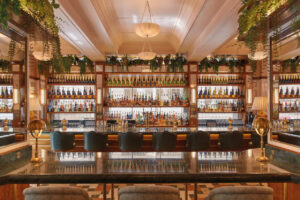
“If you haven’t got a strong narrative, by the time you get to the middle stage of the design and you’re trying to hang your hat on an idea, there’s nothing for you to base decisions on. It’s interior design at the end of the day – there are a million choices we could make but we need something to guide us.”
I asked the team about location and how instrumental that can be to a narrative. Tom explained that they have live projects across the US, in Mexico, the Middle East, Paris and the UK and he said: “One of the benefits for us is really letting those places determine a lot of the look and feel of the project. Working with San Carlo – we completed Cicchetti in Knightsbridge, and we are doing Cicchetti in Miami which will have a very different look and feel.”
Andy interjected and, whilst he agreed that location is often the starting point, the team have found that some recent projects have wanted to lead with experiential elements. “It almost doesn’t matter where they are, because they pay no homage whatsoever to the building or locality because it’s a total transportation to a different world. There are two projects that we’re working on, one in Mayfair and one in Bahrain, where the concept of the space is to feel like you’re transported into another world as you step through the door.”
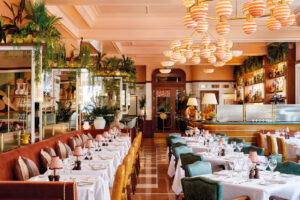
And what about the menu? What influence does that have on the narrative of an F&B design? Tom believes that depends entirely on the client. He explained that for most teams, the concept will be focussed on the menu as the food is such a big part of what they are doing, but for others it holds much less importance. “There’s a lot of restaurants out there where everything is set out around the overriding food concept and often the menu is the first thing that will be developed, especially if it’s a chef-led brand or client team.”
Andy expanded on this, saying that sometimes, the food concept is broadly understood at the inception, but the overriding priority is the feeling of the space. In contrast, for places like Cicchetti which has a small plate sharing concept, you need a bigger table than you would for other San Carlo restaurants.
Tom agreed and said: ‘I think a lot of the best places are those where you can see how the overall feel of the space ties in very directly to the F&B concept, and everything feels very seamless. I think they’re probably the most successful places.”
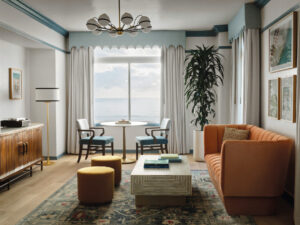
What’s next?
So what is next for this seemingly unstoppable duo? They joked that, on a personal level, the goal is to survive! With both now balancing young families with the running of the studios, life is exceptionally busy. But it’s clear that building their team, building the client portfolio and building the range across their project base is still a priority for Fettle. Tom said: “What’s exciting for us is just tackling different kinds of projects. The variety of what we are working on is great – resorts in Mexico, restaurants in Vietnam, projects in London. The variety on a studio level is really exciting.”
Andy agreed: “We don’t want to get known for doing the same type of project every time and this variety is great for the whole team.”
So watch this space, it seems that from Fettle, the best is yet to come!


